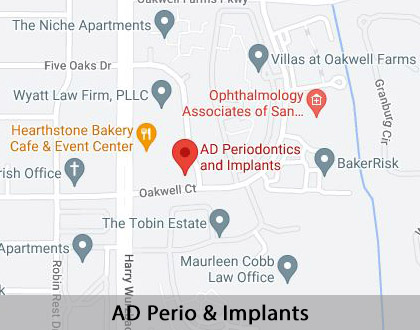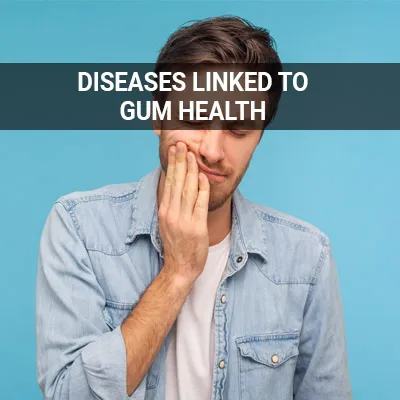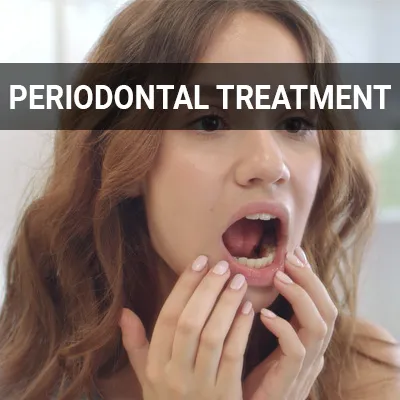Periodontal Tooth Loss San Antonio, TX
Periodontal tooth loss most often occurs as a result of periodontal disease, a condition in which the gums become infected and inflamed. Periodontal disease, or periodontitis, is the most severe form of gum disease and develops due to improper care and treatment. While it is possible to prevent periodontal tooth loss, it is also possible to treat a variety of tooth-replacement methods.
Treatment for periodontal tooth loss is available at AD Perio & Implants in San Antonio and the surrounding area. Our team can help diagnose, treat, and prevent tooth loss while providing patients with the education and tools needed to better care for their oral health. Call us today at (210) 805-8400 to schedule an appointment or learn more about our services.
What is Periodontal Tooth Loss?
Periodontal disease, or periodontitis, is one of the leading causes of tooth loss. According to the Centers for Disease Control and Prevention (CDC), "47.2% of adults aged 30 years and older have some form of periodontal disease." Periodontitis causes the gums to pull away from the teeth, weakening the gums, teeth, and underlying bone, eventually leading to tooth loss.
Periodontitis commonly results from the accumulation of bacteria, plaque, and tartar. Plaque, or the sticky film found on the surfaces of teeth, can be removed through proper brushing and flossing. However, when plaque builds up, it hardens and turns into tartar which can only be removed with professional dental tools.
“Periodontal disease, or periodontitis, is one of the leading causes of tooth loss.”
Common Causes of Periodontal Tooth Loss
Although it is possible to remove plaque through proper oral hygiene practices, it quickly re-forms on the teeth any time we eat or drink. Once plaque turns into tartar, it is only possible to remove it with services from a dental professional. That is why it is crucial that patients visit their dentist regularly for checkups and dental cleanings as well as practice good oral hygiene habits at home. According to the World Health Organization (WHO), the main causes of periodontal tooth loss are poor oral hygiene habits and tobacco use, resulting in the accumulation of tartar.
Gum disease progresses into periodontitis through several steps:
- Plaque builds up on the teeth
- Plaque turns into tartar (calculus)
- The newly-formed plaque can lead gingivitis
- Continuing gum inflammation causes periodontitis
Plaque forms on the teeth when bacteria combines with starches and sugars from food. Even though brushing and flossing can easily remove the plaque, it can quickly reform each time a patient eats food. If people do not clean their teeth on a regular basis, then the plaque will harden under the gumline and turn into tartar. Thus patients will need to receive professional dental care to remove the tartar. Untreated gum disease can eventually cause pockets to develop between the gums and teeth, allowing space for bacteria to grow. Untreated bacteria will lead to tissue, bone, and tooth loss.
"Periodontitis commonly results from the accumulation of bacteria, plaque, and tartar."
Symptoms of Periodontal Tooth Loss
The main signs of periodontal tooth loss are tender, weak gums, and loose teeth. Once this occurs, patients should seek immediate oral treatment since the gum disease has likely progressed into periodontal disease.
The following are warning signs of progressing periodontitis, according to the CDC:
- Any change in the fit of partial dentures
- Any change in the way the teeth fit together when biting
- Bad breath or bad taste that does not go away
- Gums that have pulled away from your teeth
- Loose teeth
- Painful chewing
- Red or swollen gums
- Sensitive teeth
- Tender or bleeding gums
However, these signs often appear in early gingivitis and moderate gum disease. Undergoing treatment in the early stages can often prevent periodontal tooth loss. When left untreated, these symptoms continue to worsen until the gums and underlying bone are too weak to hold the teeth in place.
"The main signs of periodontal tooth loss are tender, weak gums and loose teeth."
Check out what others are saying about our dental services on Yelp: Periodontal Tooth Loss in San Antonio, TX
Risk Factors for Periodontal Tooth Loss
As previously mentioned, periodontal tooth loss most commonly occurs due to inadequate oral hygiene and untreated oral health conditions. Thus, patients at the highest risk for developing periodontal disease and facing periodontal tooth loss are those who do not properly brush and floss at home and regularly miss routine checkups and cleanings.
Certain risk factors can also make one more susceptible to developing periodontal disease, including:
- Conditions that affect the immune system, such as HIV or leukemia
- Genetics
- Hormonal changes in women that make the gums more sensitive, such as menstruation, pregnancy, or menopause
- Medications that reduce the flow of saliva in the mouth or cause dry mouth
- Obesity
- Poor nutrition, including a deficiency in vitamin C
- Smoking, which is one of the biggest risk factors for periodontitis
- Type 2 diabetes
Patients with any of these conditions or risk factors are typically monitored by their primary care physician and dentist. In most cases, periodontal tooth loss can be prevented by treating these conditions and altering medications to reduce their effect on the gums and overall oral health.
"Certain risk factors can also make one more susceptible to developing periodontal disease, including conditions that affect the immune system, such as HIV or leukemia."
Questions Answered on This Page
Q. What is periodontal tooth loss?
Q. What are the most common cause of periodontal tooth loss?
Q. What are the most common signs and symptoms of periodontal tooth loss?
Q. What are the risk factors of periodontal tooth loss?
Q. What treatment options are available for periodontal tooth loss?
People Also Ask
Q. What are some possible complications of unhealthy gums?
Q. What types of gum medications are there? What medications get prescribed for certain gum conditions?
Q. How can a periodontist reduce the impact of gum disease?
Q. What are the symptoms of periodontal disease?
Q. What are the kinds of non-surgical periodontal procedures?
Treatments for Periodontal Tooth Loss
The main objective of treating periodontal disease is to remove all bacteria and infection within the gum pockets in order to stop the disease and prevent further damage to the gums and underlying bone. Treatments for periodontal disease may include a scaling and root planing procedure, medicated mouthwashes and prescription drugs, flap surgery, bone and tissue grafts, and guided tissue regeneration (GTR). The type of treatment will depend on the patient's condition, current oral and general health status, and the severity of their gum disease. If a patient has already experienced tooth loss, we will discuss their tooth-replacement options and immediately initiate treatment to prevent further disease progression and tooth loss.
Periodontitis is a chronic inflammatory condition that will recur if good oral hygiene is not maintained. It is crucial that patients brush and floss adequately as instructed by their dentist. We will schedule a follow-up appointment after the patient's treatment to ensure their oral health is progressing and make alterations to their treatment plan as needed. We will also provide them with the tools needed to properly care for and maintain healthy gums at home, along with prescription medications that may assist with their healing and ongoing care.
"If a patient has already experienced tooth loss, we will discuss their tooth-replacement options and initiate treatment immediately to prevent further progression of the disease and future tooth loss."
Frequently Asked Questions
Q. What are the main causes of periodontal tooth loss?
A. The most common cause of periodontal tooth loss is periodontal disease and advanced periodontitis, which results from poor oral hygiene. Other causes of periodontal tooth loss include untreated tooth decay, tobacco use, and excessive alcohol consumption. However, these causes are ultimately due to plaque and tartar buildup that is left untreated.
Q. How can I prevent periodontal tooth loss?
A. As periodontal tooth loss commonly results due to an accumulation of plaque, it is important that plaque and tooth decay are properly treated. We advise patients to brush and floss at least twice daily, use an antibacterial mouthwash, and regularly visit their dentist for routine dental exams and cleanings. Although this may seem like basic oral care practices, periodontal disease typically develops from a lack of oral care and maintenance.
Q. What are my treatment options if I lose a tooth?
A. For cases in which a patient experiences tooth loss, we will carefully assess their case, examine their entire oral cavity, and discuss tooth-replacement options. These options may include dental implants, dentures, crowns, or bridges. We will also provide a treatment to prevent the disease from spreading and avoid future tooth loss.
Q. How common is periodontal tooth loss?
A. Periodontal tooth loss is common in patients with periodontal disease or advanced periodontitis. According to the CDC, "About 2 in 3 (68%) adults aged 65 years or older have gum disease and nearly 1 in 5 adults aged 65 or older have lost all of their teeth. Complete tooth loss is twice as prevalent among adults aged 75 and older (26%) compared with adults aged 65-74 (13%)."
Q. What symptoms usually accompany gum or periodontal disease?
A. The most common symptoms of developing periodontal disease are swelling of the gums, red and tender gums, tooth sensitivity, painful chewing, spaces between the teeth, bleeding gums, and bad breath. Patients who experience these symptoms should seek immediate care by a dentist or periodontist.
Start Feeling Better - Visit Us Today
By visiting us as soon as possible, our team can help get you the professional treatment you need. Instead of waiting around and allowing the symptoms to get worse, we can provide you with treatment options.
Definitions
Call Us Today
Periodontal tooth loss can be effectively treated. Do not hesitate to seek treatment for tooth loss. We can help create a natural-looking smile and provide you with the tools you need to avoid tooth loss in the future. Call us today at 210-805-8400 to schedule an appointment or learn more about our services.
Helpful Related Links
- American Academy of Periodontology (AAP). American Academy of Periodontology (AAP). 2023
- Center for Disease Control and Prevention (CDC), Periodontal Disease Page. Center for Disease Control and Prevention (CDC), Periodontal Disease Page. 2023
- WebMD, What Is a Periodontist?. WebMD, What Is a Periodontist?. 2023
About our business and website security
- AD Perio & Implants was established in 2020.
- We accept the following payment methods: American Express, Cash, Check, Discover, MasterCard, and Visa
- We serve patients from the following counties: Bexar County, Kendall County, Comal County, and Guadalupe County
- We serve patients from the following cities: San Antonio, Alamo Heights, Terrell Hills, Universal City, Boerne, Stone Oak, New Braunfels, Bulverde, Fair Oaks Ranch, Garden Ridge, Selma, and Castle Hills
- Norton Safe Web. View Details
- Trend Micro Site Safety Center. View Details
Back to top of Periodontal Tooth Loss







